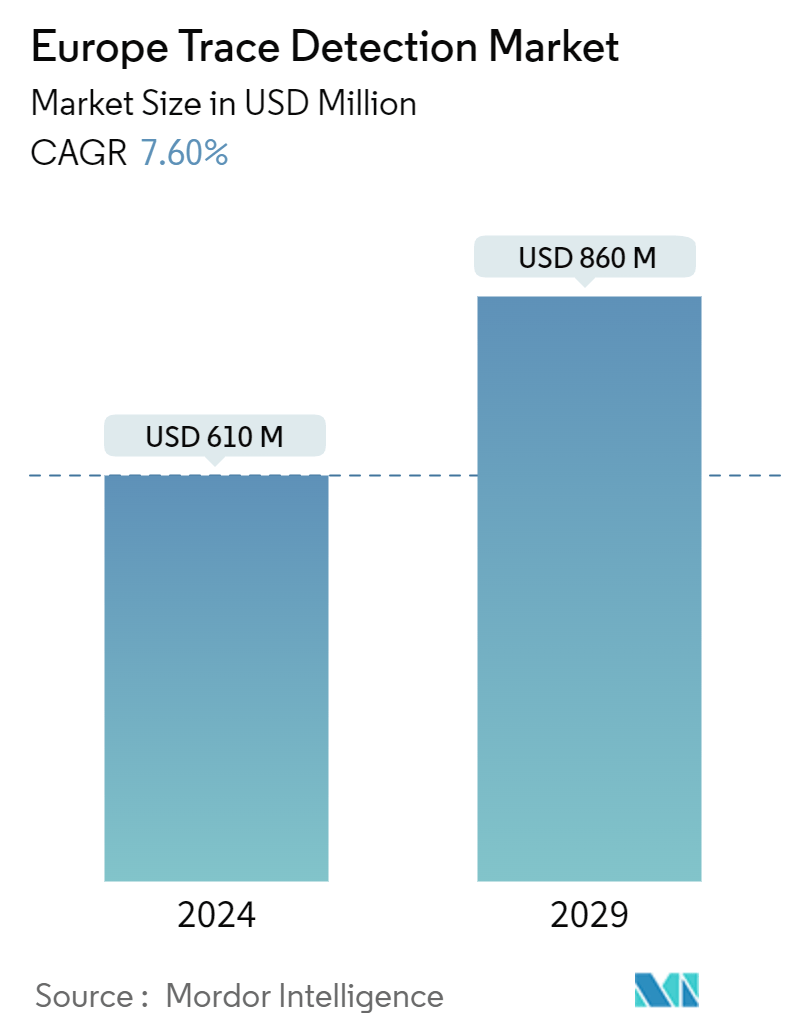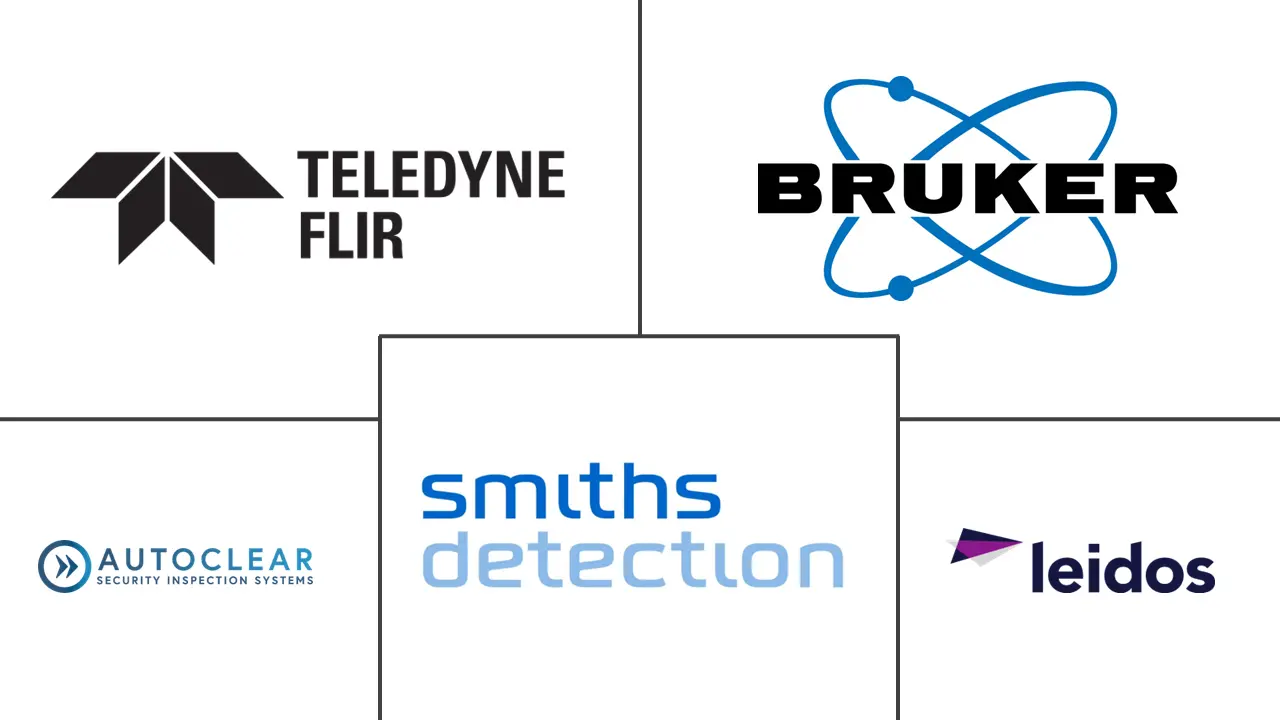Market Size of Europe Trace Detection Industry

| Study Period | 2022 - 2029 |
| Base Year For Estimation | 2023 |
| Market Size (2024) | USD 610 Million |
| Market Size (2029) | USD 860 Million |
| CAGR (2024 - 2029) | 7.60 % |
| Market Concentration | Medium |
Major Players
*Disclaimer: Major Players sorted in no particular order |
Europe Trace Detection Market Analysis
The Europe Trace Detection Market size is estimated at USD 610 million in 2024, and is expected to reach USD 860 million by 2029, growing at a CAGR of 7.60% during the forecast period (2024-2029).
- With the rising terror attack threats at various public gatherings, trace detection plays a vital role, especially for places like government organizations, concerts, schools, transportation, and many others, to help reduce and mitigate associated risk factors.
- Trace detectors can identify deficient levels of substances, like chemicals, drugs, explosives, or trace elements, in various samples. They are employed in multiple applications like security, forensics, and industrial processes. Many trace detectors operate non-destructively. They can also be highly selective in detecting specific substances, allowing for targeted analysis and identification. The increasing use of trace detectors in the military and defense sector, owing to their ability to detect hidden explosives like bombs, improvised explosive devices, and chemical warfare agents, is anticipated to drive the market's growth significantly.
- In civil security, explosives have been detected mainly by stationary stand-alone devices, such as at airport security gates. The portable devices currently available on the market, weighing an average of five kilograms, are suitable only for a few mobile applications. Additionally, the maintenance and cleaning of these devices are very cost-intensive.
- To tackle the issue, in May 2023, a team of founders from the Federal Institute for Materials Research and Testing announced that they were striving to develop a mobile explosives trace detector market that detects explosives more reliably, making an essential contribution to security in the civil sector.
- However, explosive trace detectors have varying sensitivity levels and may not detect trace amounts of explosives. Also, the sampling techniques can influence the detectors' effectiveness. Proper sampling and collection of trace samples are crucial for accurate results. Inadequate sampling may lead to false negatives or false positives. Moreover, failure to calibrate or maintain the equipment can affect its accuracy and reliability. These factors may restrain the growth of the market.
- Further, implementing and maintaining trace detection systems can be costly, especially for organizations with limited budgets. The high cost of acquiring and operating screening systems can be expensive. Also, regular training and employing skilled personnel can significantly restrain the market.
- Moreover, the conflict between Russia and Ukraine will significantly impact the industry. The conflict has already exacerbated the semiconductor supply chain issues, and the chip shortage has affected the industry for some time. The disruption may result in volatile pricing for critical raw materials such as nickel, palladium, copper, titanium, aluminum, and iron ore, resulting in material shortages. This, in turn, could impact manufacturing of various trace detection equipment. Further, according to UkraineInvest, copper prices escalated to USD 10,845/mt in early March 2022. The ongoing war between Russia and Ukraine, high energy costs, and stricter emissions standards in Europe have been noted as the primary reasons for the continued shortage of copper.
Europe Trace Detection Industry Segmentation
Trace detection refers to the process of detecting or identifying minute or trace amounts of a substance or material. Trace detection involves collecting samples from surfaces, objects, or the environment and analyzing them, then using specialized equipment or methods to detect the target substance at very low concentrations.
The European trace detection market is segmented by type (explosive and narcotics), product (handheld, portable/movable, and fixed), end-user industry (commercial, military and defense, law enforcement, ports and borders, public safety, and other end-user industries), and country (United Kingdom, Germany, France, and Rest of Europe). The report offers the market sizes and forecasts for all the above segments in value (USD).
| By Type | |
| Explosive | |
| Narcotics |
| By Product | |
| Handheld | |
| Portable/Movable | |
| Fixed |
| By End-user Industry | |
| Commercial | |
| Military and Defense | |
| Law Enforcement | |
| Ports and Borders | |
| Public Safety | |
| Other End-user Industries |
| By Country | |
| United Kingdom | |
| Germany | |
| France | |
| Italy | |
| Spain |
Europe Trace Detection Market Size Summary
The European trace detection market is poised for significant growth, driven by increasing security concerns and the need for advanced detection technologies across various sectors. The market is characterized by the rising demand for trace detectors in security, forensics, and industrial applications, particularly in response to threats such as terrorism and illegal activities. These detectors are crucial for identifying trace amounts of chemicals, drugs, and explosives, and are extensively used in military, defense, and law enforcement agencies. The market is also influenced by the ongoing conflict between Russia and Ukraine, which has impacted the supply chain and pricing of essential raw materials, thereby affecting the manufacturing of trace detection equipment. Despite challenges such as high costs and varying sensitivity levels of detectors, the market is expected to expand due to increased government spending on security and defense, particularly in the United Kingdom.
The market landscape is semi-consolidated, with key players like Smiths Detection Group, Leidos Holdings, Inc., and Bruker Corporation leading the charge in innovation and product development. These companies are investing heavily in research and development to enhance their offerings and meet the evolving needs of consumers. Recent advancements include the introduction of next-generation trace detection systems, such as Bruker's DE-tector flex, which are set to replace older models in major European airports. The market's growth is further supported by strategic collaborations and contracts, such as those awarded to OSI Systems, Inc. for providing explosive trace detection systems at airport checkpoints. As security threats continue to evolve, the demand for reliable and efficient trace detection technologies is expected to rise, driving the market's expansion in the coming years.
Europe Trace Detection Market Size - Table of Contents
-
1. MARKET INSIGHTS
-
1.1 Market Overview
-
1.2 Technology Snapshot
-
1.3 Industry Value Chain Analysis
-
1.4 Industry Attractiveness - Porter's Five Forces Analysis
-
1.4.1 Threat of New Entrants
-
1.4.2 Bargaining Power of Consumers
-
1.4.3 Bargaining Power of Suppliers
-
1.4.4 Threat of Substitute Products
-
1.4.5 Intensity of Competitive Rivalry
-
-
1.5 Impact of COVID-19 Aftereffects and Other Macroeconomic Factors on the Market
-
-
2. MARKET SEGMENTATION
-
2.1 By Type
-
2.1.1 Explosive
-
2.1.2 Narcotics
-
-
2.2 By Product
-
2.2.1 Handheld
-
2.2.2 Portable/Movable
-
2.2.3 Fixed
-
-
2.3 By End-user Industry
-
2.3.1 Commercial
-
2.3.2 Military and Defense
-
2.3.3 Law Enforcement
-
2.3.4 Ports and Borders
-
2.3.5 Public Safety
-
2.3.6 Other End-user Industries
-
-
2.4 By Country
-
2.4.1 United Kingdom
-
2.4.2 Germany
-
2.4.3 France
-
2.4.4 Italy
-
2.4.5 Spain
-
-
Europe Trace Detection Market Size FAQs
How big is the Europe Trace Detection Market?
The Europe Trace Detection Market size is expected to reach USD 610 million in 2024 and grow at a CAGR of 7.60% to reach USD 860 million by 2029.
What is the current Europe Trace Detection Market size?
In 2024, the Europe Trace Detection Market size is expected to reach USD 610 million.

